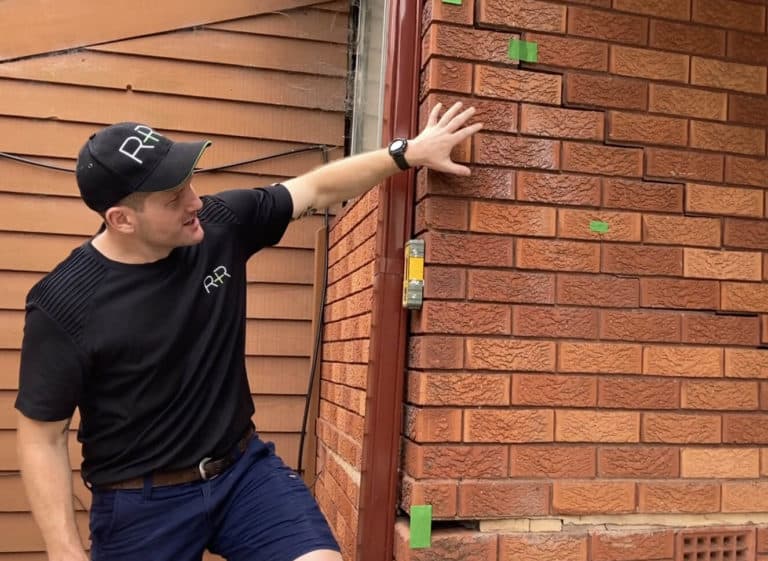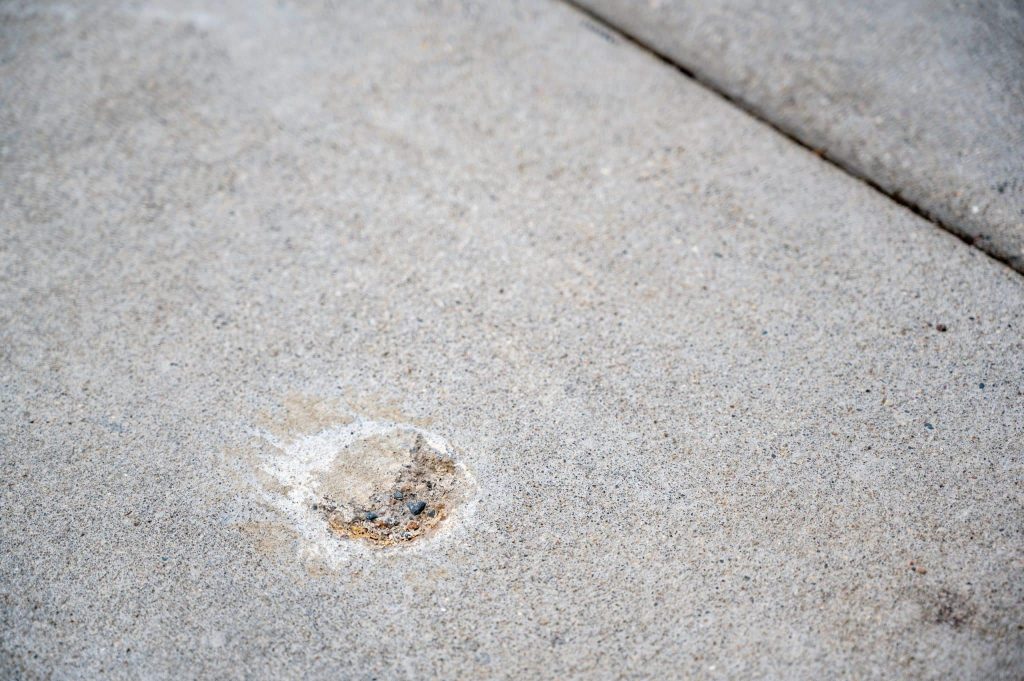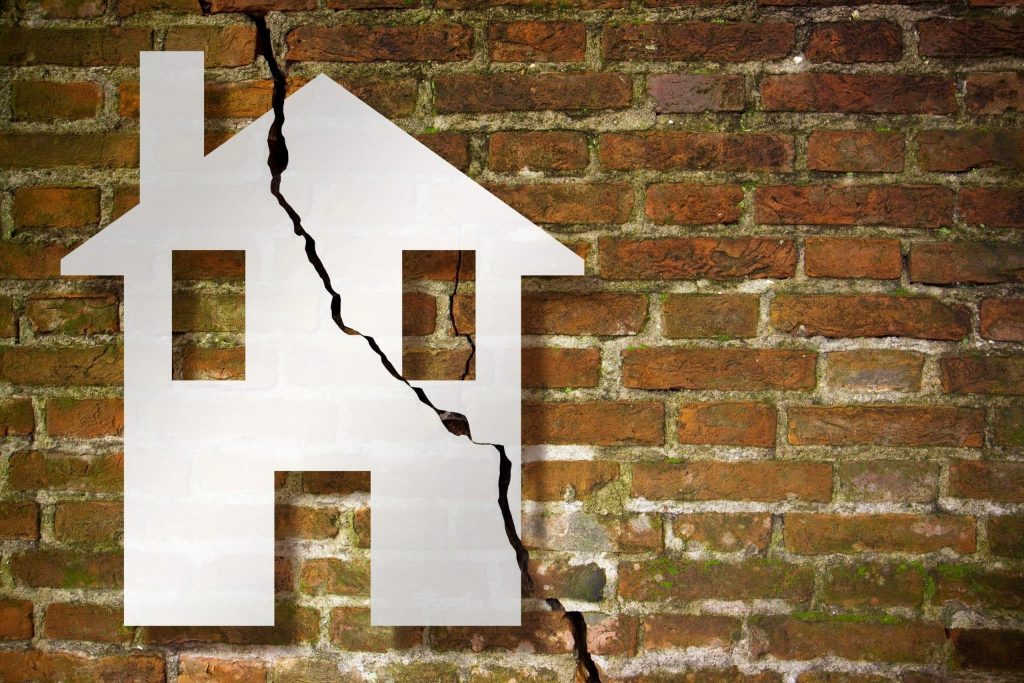Subsidence is when the ground under your home sinks or moves, which can cause parts of the house to crack, tilt, or become uneven. It can lower your home’s value by making it hard to sell or expensive to repair.
The following are all strong indicators of subsidence.
- Sloping or sinking floors
- Zigzag patterned cracks in walls
- Uneven concrete slabs on driveways or pathways
- Doors and windows that get jammed or are misaligned
- Puddles forming around the house’s perimeter
In residential properties across Brisbane, Melbourne, Sydney, and the rest of Australia, subsidence happens when the ground beneath your home shifts or sinks. This can cause structural issues like wall cracks, sinking foundations, and uneven floors.
If left untreated, land subsidence can severely affect the foundation of your home. Additionally, it can also lead to a major drop in the value of your property.
In these circumstances, your best bet is to contact an experienced re-levelling company, such as ours. We can provide you with expert solutions to repair subsidence damage and protect your biggest investment.
Common signs of subsidence every homeowner should know
According to a study by the Australian Bureau of Statistics, 11% of Australian households reported major structural issues with their current home.
Subsidence can lead to future costs if it’s left too long, so it’s important to spot and react to signs of subsidence as soon as possible. Doing so can potentially save you thousands in repairs and help maintain the value of your home.
One of the most obvious indicators of subsidence is cracks in the walls, both inside and outside the property. These cracks often appear around doors and windows or may run diagonally across walls.
Uneven floors and sloping surfaces are another red flag to look out for, as this often indicates the ground beneath your home is shifting. You might also notice doors and windows sticking or failing to close properly. This is a classic symptom of foundation movement.
In more advanced cases, foundation cracks or visibly sinking foundations may be evident from the outside of your property. Additionally, another tell-tale sign is when gaps start appearing between walls and ceilings. This may suggest that your home’s structure is no longer level.
All these symptoms point to potential foundation issues caused by land subsidence, reactive clay soil, or changes in underground water levels.
When and why subsidence can happen to homes
Subsidence doesn’t just happen overnight. Instead, it’s usually the result of gradual changes under the surface over a significant period of time. For this reason, the more you can understand the causes, the quicker you’ll be able to act before major subsidence damage occurs.
One of the most common triggers is groundwater-related issues, such as changes in soil moisture. They’re often the result of leaking pipes, poor drainage, or long periods of drought.
This is especially true for clay soils, which naturally expand when wet and shrink during dry spells. Over time, this movement can lead to wall cracks, uneven floors, and sinking foundations throughout your home.
Soil compaction also plays a major role because if the soil around your home wasn’t properly compacted during construction, or if heavy excavation or building work nearby disrupts it, the ground can shift. This shift can cause your home to settle unevenly.
Additionally, foundation problems, such as inadequate construction, aging materials, or a lack of maintenance, can leave your home more vulnerable to subsidence. In some areas, especially remote parts of Queensland and Victoria, mining subsidence is also a risk, particularly where old mining activity has left empty spaces underground.
Regardless of the cause of your subsidence, recognising the early signs of it is vital to protecting your home’s structure and its value.
How subsidence affects your home’s value and safety
If left unchecked, subsidence can have a big impact on your property’s resale value. The Department of the Environment reported that visible issues like cracks and uneven floors can put off potential buyers.
Beyond property value, the safety risks associated with subsidence are just as worrying. As the ground beneath your home shifts or sinks, it can compromise the foundation of your home.
This movement can lead to structural issues such as unstable walls and floors, which can make your home unsafe. This is especially true if cracks appear near structural points like windows, door frames, or load-bearing walls.
It is not advisable to ignore subsidence because if you do, it can lead to far greater long-term costs. What starts as a few hairline cracks could eventually require foundation repairs, wall rebuilding, or even a full home underpinning.
However, the fact that you’re here reading this is a great sign, as you’re already thinking about early detection and how to get the right help.
Subsidence repair: how to fix and stabilise your home
If your home is starting to subside, now is the time to catch it early. The sooner you get help, the less you’ll likely have to pay in the future.
One option for subsidence repair is re-levelling, which lifts and stabilises your home by restoring the foundation to its proper position. It also helps strengthen the ground underneath to prevent future movement.
Some of the more common re-levelling techniques include underpinning and mudjacking. Underpinning involves adding new support beneath the foundation, while mudjacking uses specialised materials injected under the slab to lift and stabilise the structure.
In addition, advanced void filling methods can also be used to stabilise the ground. This remedy helps to eliminate dangerous gaps caused by land subsidence or sinkhole activity.
If you’ve noticed cracks in walls, uneven floors, or other signs your home is subsiding, don’t wait. The best action course is to contact relevant professionals who can assess the reasons for the sinking concrete and suggest remedial solutions. It’s essential, however, to take every measure to prevent the occurrence of subsidence, as if left untreated, it can cause costly structural damage.
Professional re-levelling services, like those offered by Raise and Relevel, deliver long-lasting results with minimal disruption to your home.
Having a structural assessment performed by a qualified expert will identify the cause of the subsidence. They can also recommend the best solution to keep your property safe and protect its value long into the future.
How to prevent subsidence and protect your home’s foundation
Some factors behind subsidence are beyond your control. However, there are steps you can take to reduce your risk and protect your home’s foundation.
One of the most important things you can do is maintain proper drainage around your home. This helps ensure your gutters, downpipes, and drainage systems are working properly to direct water away from the base of your house, preventing the ground underneath from softening.
Regularly inspecting your foundation for early warning signs like cracks in the wall or minor settling will go a long way towards helping you catch issues before they become major problems.
Another good strategy is to keep soil moisture consistent, especially if you live in an area with reactive clay soil. That means avoiding extremes, so don’t let the ground get too dry during droughts, but also be careful not to overwater. If you’re not under water restrictions, using soaker hoses or regular light watering during dry spells can help keep things balanced.
If you live in an area with reactive clay soil, tree roots can make the ground shrink even more by drawing out moisture. So if you’re planting trees, it’s best to keep them well away from your home to reduce the risk of subsidence.
Summing up
Subsidence can be a challenge, but keeping an eye out for early signs is a smart way to protect both your home’s safety and value. The sooner it’s identified, the easier it is to manage and resolve.
Using proven techniques such as underpinning, void filling, and advanced subsidence repair methods, the team at Raise and Relevel provide long-term solutions to counteract subsidence.
Backed by over a century of combined experience, we are experts at what we do. We also offer competitive pricing and industry-leading warranties to give our clients peace of mind.
If you’ve noticed any signs of house subsidence, wall cracks, or uneven floors on your property, contact us today to arrange a comprehensive structural assessment.
FAQs
What are the main causes of subsidence?
Subsidence can happen for a few different reasons, like droughts drying out the soil, tree roots growing too close to your home, leaking pipes, or old underground mining. Poor drainage and weak soil can also make the ground less stable.
How do I know if my home is subsiding?
Typical signs your home is subsiding include cracks in walls, uneven floors, sticking doors or windows, and gaps between walls and ceilings. If you notice any of these, it’s important to seek a structural assessment to identify the issue early.
Can subsidence settlement be fixed permanently?
Yes. Modern subsidence solutions like underpinning, void filling, and soil stabilisation can fix subsidence settlement and prevent further structural issues.
What should I do if I suspect land subsidence near my property?
If you notice changes like new cracks, uneven floors, or doors sticking, it’s worth having a professional assess your home. In some cases, geologic surveys or soil reports can help confirm if the ground is subsiding and what’s causing it.





